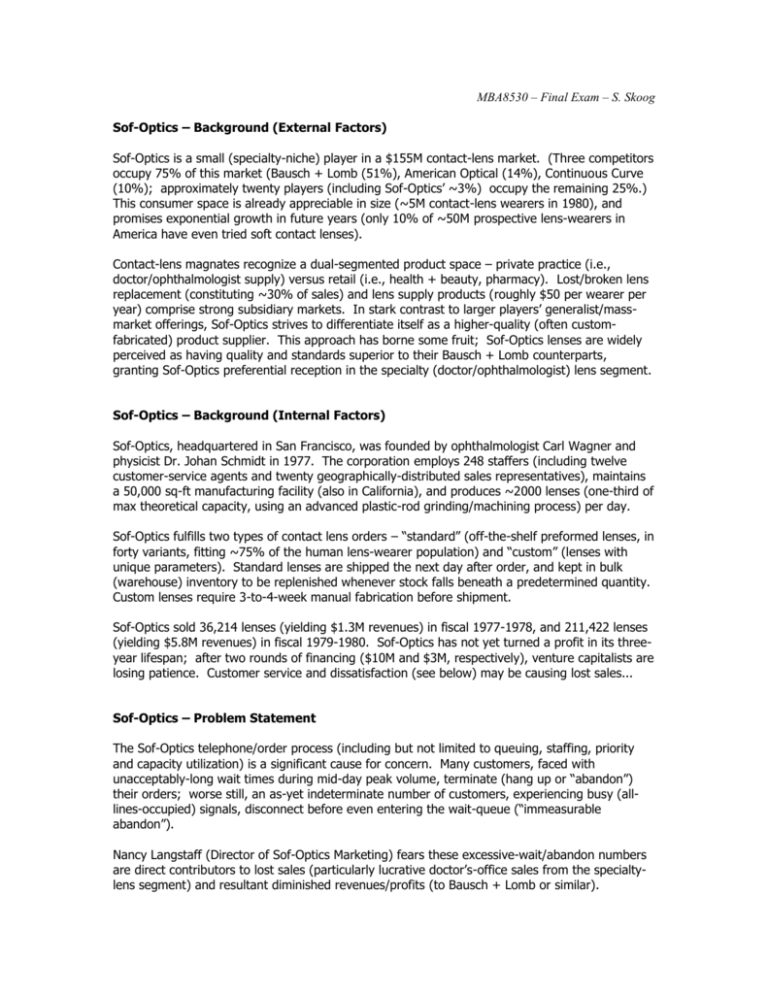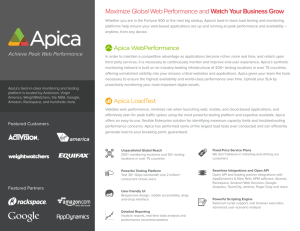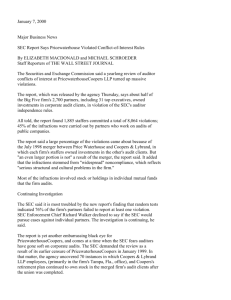MBA8530 – Final Exam – S
advertisement

MBA8530 – Final Exam – S. Skoog Sof-Optics – Background (External Factors) Sof-Optics is a small (specialty-niche) player in a $155M contact-lens market. (Three competitors occupy 75% of this market (Bausch + Lomb (51%), American Optical (14%), Continuous Curve (10%); approximately twenty players (including Sof-Optics’ ~3%) occupy the remaining 25%.) This consumer space is already appreciable in size (~5M contact-lens wearers in 1980), and promises exponential growth in future years (only 10% of ~50M prospective lens-wearers in America have even tried soft contact lenses). Contact-lens magnates recognize a dual-segmented product space – private practice (i.e., doctor/ophthalmologist supply) versus retail (i.e., health + beauty, pharmacy). Lost/broken lens replacement (constituting ~30% of sales) and lens supply products (roughly $50 per wearer per year) comprise strong subsidiary markets. In stark contrast to larger players’ generalist/massmarket offerings, Sof-Optics strives to differentiate itself as a higher-quality (often customfabricated) product supplier. This approach has borne some fruit; Sof-Optics lenses are widely perceived as having quality and standards superior to their Bausch + Lomb counterparts, granting Sof-Optics preferential reception in the specialty (doctor/ophthalmologist) lens segment. Sof-Optics – Background (Internal Factors) Sof-Optics, headquartered in San Francisco, was founded by ophthalmologist Carl Wagner and physicist Dr. Johan Schmidt in 1977. The corporation employs 248 staffers (including twelve customer-service agents and twenty geographically-distributed sales representatives), maintains a 50,000 sq-ft manufacturing facility (also in California), and produces ~2000 lenses (one-third of max theoretical capacity, using an advanced plastic-rod grinding/machining process) per day. Sof-Optics fulfills two types of contact lens orders – “standard” (off-the-shelf preformed lenses, in forty variants, fitting ~75% of the human lens-wearer population) and “custom” (lenses with unique parameters). Standard lenses are shipped the next day after order, and kept in bulk (warehouse) inventory to be replenished whenever stock falls beneath a predetermined quantity. Custom lenses require 3-to-4-week manual fabrication before shipment. Sof-Optics sold 36,214 lenses (yielding $1.3M revenues) in fiscal 1977-1978, and 211,422 lenses (yielding $5.8M revenues) in fiscal 1979-1980. Sof-Optics has not yet turned a profit in its threeyear lifespan; after two rounds of financing ($10M and $3M, respectively), venture capitalists are losing patience. Customer service and dissatisfaction (see below) may be causing lost sales... Sof-Optics – Problem Statement The Sof-Optics telephone/order process (including but not limited to queuing, staffing, priority and capacity utilization) is a significant cause for concern. Many customers, faced with unacceptably-long wait times during mid-day peak volume, terminate (hang up or “abandon”) their orders; worse still, an as-yet indeterminate number of customers, experiencing busy (alllines-occupied) signals, disconnect before even entering the wait-queue (“immeasurable abandon”). Nancy Langstaff (Director of Sof-Optics Marketing) fears these excessive-wait/abandon numbers are direct contributors to lost sales (particularly lucrative doctor’s-office sales from the specialtylens segment) and resultant diminished revenues/profits (to Bausch + Lomb or similar). MBA8530 – Final Exam – S. Skoog Sof-Optics – Data Supporting Problem Statement Exhibit 8 shows 81-sec avg customer wait time (approaching 127 sec during 10:00-to-2:00 peak). It can be reasonably assumed that excessive wait time is causing customer dissatisfaction, as Sof-Optics is experiencing premature order termination. What does this wait-time mean for Customer-Svc Reps during peak hours? Incoming calls range from 47 to 75 calls per half-hour in the 10-to-2 window; if each incoming call requires 130.65 sec to process on average (calculations shown on next page), plus 82-to-127 seconds’ delay per call, this means 47 to 75 calls at peak => => => => 6140 to 9798 sec during peak + 3872 to 9540 sec delay at peak 10012 to 19338 sec, inc. delays at peak 166 to 322 minutes at peak Which is to say, certain very-egregious peak conditions may emerge beyond 8 staffers’ ability to cover (8 staff x 30 min = 240 staff-minutes, 240 staffminutes cannot cover 322 min of calls + delays even in perfect conditions). Exhibit 8 shows 136/1164 = 11.7% avg customer abandons (approaching 34.1% during peak). There is a second (difficult-to-measure) cause of customer abandonment (i.e., customers who reach busy (all-12-lines-occupied) signal w/o a wait). Though not explicitly given in the case, extrapolating a rough parabolic trend-line from Exhibit 8 data (see attached spreadsheet + curve diagram)… area under this curve looks like approximately 156 additional calls (which would make 1321 total) …suggests as many as 156/1321 = 11.8% additional busy-signal customer abandonments (in the 10:00-to-13:30 timeframe) may be happening before the customer even reaches a pre-recorded hold/wait message. Clearly lost sales amounting to 11.7% to 23.5% ($680K to $1.37M, as a portion of Exhibit 1 FY80 revenues) are unacceptable! Even the low end of this range (~$680K) would have turned FY80 loss into $300K profit. MBA8530 – Final Exam – S. Skoog Sof-Optics – Data Supporting Problem Statement (cont.) What should Sof-Optics’ daily call volume look like? Statistics detailing call-categories (Exhibit 3) can be used to compile average-call-length, average-service-time, and thus max-daily-capacity. An Average Customer Call (handled by Customer-Service Rep): (60% are 85 sec) + (15% are 120 sec) + (15% are 220 sec) + (5% are 450 sec) + (3% are 125 sec) + (2% are 120 sec) = 130.65 sec = 37.5 sec An Average Customer Call (handled by Data-Entry Operator): (60% are 30 s) + (15% are 40 s) + (5% are 240 s) + (3% are 50 s) Assuming perfection (no busy-signals, no customer-abandons), a Customer-Svc Rep can handle (8 hrs) ÷ (130.65 sec) = 220.4 calls/day, or 206.6 calls/day with a 30-min break. A Data-Entry Operator can handle (8 hrs) ÷ (37.5 sec) = 768 calls/day, or 720 calls/day with a 30-min break. 8 Cust-Svc Reps => 1652 to 1763 calls/day (theoretical max capacity) actual (Exhibit 5) performance is 159 to 166 calls/day, which (over 8 staffers) should be 1272 to 1328 calls/day. Cust-Svc Reps are operating at 75.3% to 77% capacity even *with* the built-in stretches of idle time estimated in Exhibit 5… handling the 11% to 23% abandon volumes calculated on the previous page should be no problem with existing staff, if said abandons could be prevented. 4 Data-Entry Opers => 2880 to 3072 calls/day (theoretical max capacity) Data-Entry Operators are nowhere near capacity. Even making the unrealistic assumption that all 1272 to 1328 calls/day require data-entry, Data-Entry Ops are operating at 43.2% to 44.2% capacity. (Exhibit 3 suggests that only 83% of calls require data-entry, so this number is actually more like 35.9% to 36.7% of capacity.) This means that Data-Entry Operations are approximately double-staffed, and could theoretically complete their current daily workload with only two data-entrants. It is important to note that, although these figures are calculated using daily/hourly averages, incoming call traffic is *not* evenly distributed; that is to say, calls are “clumped” (highest incoming-call volume hovers at 64-to-71 calls between 09:30 and 14:30), as are delayed-calls (highest number-of-delayed-calls hovers at 60-to-68 between 10:00 and 14:00) and delay-percall (highest delay ranges 82-to-127 seconds between 10:00 and 13:30). Though Jane Scott has attempted to compensate for these “clumps” via staggered shifts (manpower most concentrated during these peak hours), these persistent logjams show her efforts to be incomplete (maxclumped calls outpace available staff time at peak, see prev. page); more attention is needed. MBA8530 – Final Exam – S. Skoog Sof-Optics – Root Cause Analysis A simple but representative Ishikawa (“fishbone”) root-cause diagram might look like this: man method / / customer svc / / customer svc reps differ / insufficient / reps not well in speed, / # of reps / trained, not training / manning the / coming up to / busy clumps, / speed fast enough, / esp. at peak / not getting calls customer calls / windows / off line fast enough are being lost / / due to delays ----+-------------------------+----------------------and/or busy\ \ signal logjams \ \ \ 12-lines max \ order-status computer \ causes some \ lookups on system \ customers \ two CRTs downtime \ to not even \ makes for causes data \ reach the \ delays, entry backlog \ wait-msg \ logjams \ \ machine materials Sof-Optics – Possible Approaches and/or Solutions Excess capacity should be diverted from the Data-Entry Operations team immediately; Customer-Service Representatives are being badly swamped at peak hours, whereas Data-Entry Operators have “cushy lives” rarely if ever burdened by backlogs or overload. If 1½ Data-Entry staffers were re-tasked to work Customer Service phones (two phones are currently idle/unused), Cust-Svc max throughput would become 1962-to-2093 calls/day (current 1272-to-1328 volume would constitute 63.4% to 64.8% of capacity), while Data-Entry max throughput would reduce to a still-manageable 1800-to-1920 calls/day (current 1081-to-1128 volume would constitute 58.8% to 60.1% of capacity). For optimum utilization, the 1½ Data-Entry staffers so re-tasked should work during busiest/peak Customer-Service hours (e.g., two staffers both working the 6-hour stretch from 08:00 to 14:00). This staffing model could sustain 50% volume growth into 1981. Alternately, supervisory staff (Ms. Scott herself) could work a customer phone line during the aforementioned 10:00-to-14:00 peak period. This action will boost capacity as above, but to a lesser extent; it has the collateral benefit of being minimally disruptive to existing staff plans. Neither of these solutions addresses the 12-lines-maximum issue. The customer-reaches-busysignal phenomenon *must* be prevented at all costs; worse even than long-wait frustration, the busy signal is literally flushing money down the drain. Two additional phone-lines are scheduled for December installation – although expensive ($1700/month per extra phone-line), if they prevent even one out of every ten customer abandonments, they will more than pay for themselves (11.7% current abandonment ≈ $680K loss per year, if reduced by one-tenth this becomes 10.5% abandon ≈ $612K loss, a $68K/yr savings for $40.8K/yr of phone-line costs). This logic could be applied to adding four phone-lines, or six, or eight, or ten or twelve… MBA8530 – Final Exam – S. Skoog Sof-Optics – Possible Approaches and/or Solutions (cont.) General (less easily quantified) human-resource issues seem to be plaguing Sof-Optics’ customer service department. Customer-Service staffers should explore new training options (it is taking too long for new hires to “ramp up” to 159-to-166 daily call volume) and/or implement bonus compensatory systems (e.g., award P paid for meeting or exceeding daily volume Q, award X paid for minimizing customer delay beneath target Y, etc.) These countermeasures may incidentally serve to mitigate Customer-Service’s excessive turnover (much greater than other sub-10% neighboring organizations). Additional Customer-Service hires are always an option (particularly if high volume growth persists through 1981 and out-years), but should *not* be considered without first procuring additional phone lines (to avoid 12-max busy) and/or re-tasking Data-Entry staffers (making use of excess capacity). Ten Customer-Service staffers can be supported before new workstation purchases become necessary. Sof-Optics – Action Plan, Implementation, Next Steps As an interim step, Customer-Service Dept. needs to re-stagger/re-task staff immediately [shift 1+ additional staffer(s) to 09:30-to-14:00 peak, or re-task Data Entry staffer(s)] Longer-term, Customer-Service Dept. must show peak/delay numbers to highers-up [present numeric justification for additional phones, workstations, staffers if needed] Add 2+ additional WATS phone-lines or retool 12-max-lines system as soon as possible [get rid of the busy-signal problem, or at least find some way of quantifying/tracking it] Consider renovating Customer-Service training curriculum, new hire ramp-up process [goal is to get cust-svc staffers up to speed faster, keep them on the job longer] Consider restructuring Customer-Service compensation, time/volume-based bonus plan [define an “acceptable” customer wait time, say <30 sec., and manage to those targets] Re-evaluate Jane Scott’s supervisory skills, consider bringing in additional assistance [possibly re-classify Ms. Scott as “shift supervisor,” making her a ninth cust-svc staffer] Introduce “thank you for holding, average wait time is now XYZ sec” recorded message [cable-supplier ComCast now uses such a recorded-message system, to marginal benefit] [even if it does not appease the frustrated customer, it may at least free up a phone line] [in Sof-Optics’ current system, the 2nd best thing a waiting customer can do is hang up] Introduce non-phone-dependent technology… e.g., secure Internet/Web-based ordering [may also reduce need for data-entry staff, but watch out for HIPAA + similar legalities] ** Sven’s Supplemental Note: Two lesser/subsidiary problems can be found in this case (inventory-mgmt and the consignment stocking system). I chose to focus on call-queues given the five-page maximum.






